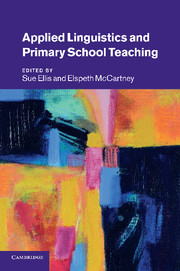Book contents
- Frontmatter
- Contents
- List of figures
- List of tables
- Notes on contributors
- Preface
- Editors' notes and conventions
- Introduction
- Part I Policy and diversity in the twenty-first-century primary school
- Part II The range and focus of applied linguistics research
- Introduction to Part II
- 6 Grammar for designers: how grammar supports the development of writing
- 7 The use of corpus-based approaches in children's knowledge about language
- 8 Words and pictures: towards a linguistic understanding of picture books and reading pedagogy
- 9 From storytellers to narrators: how can the history of reading help with understanding reading comprehension?
- 10 Talk about text: the discursive construction of what it means to be a reader
- 11 Why we need to know about more than phonics to teach English literacy
- 12 Understanding children's reading comprehension difficulties
- 13 Classroom discourse: the promise and complexity of dialogic practice
- 14 Pedagogy and bilingual pupils in primary schools: certainties from applied linguistics
- Part III Empowering teachers and teachers' use of knowledge
- References
- Index
7 - The use of corpus-based approaches in children's knowledge about language
Published online by Cambridge University Press: 26 April 2011
- Frontmatter
- Contents
- List of figures
- List of tables
- Notes on contributors
- Preface
- Editors' notes and conventions
- Introduction
- Part I Policy and diversity in the twenty-first-century primary school
- Part II The range and focus of applied linguistics research
- Introduction to Part II
- 6 Grammar for designers: how grammar supports the development of writing
- 7 The use of corpus-based approaches in children's knowledge about language
- 8 Words and pictures: towards a linguistic understanding of picture books and reading pedagogy
- 9 From storytellers to narrators: how can the history of reading help with understanding reading comprehension?
- 10 Talk about text: the discursive construction of what it means to be a reader
- 11 Why we need to know about more than phonics to teach English literacy
- 12 Understanding children's reading comprehension difficulties
- 13 Classroom discourse: the promise and complexity of dialogic practice
- 14 Pedagogy and bilingual pupils in primary schools: certainties from applied linguistics
- Part III Empowering teachers and teachers' use of knowledge
- References
- Index
Summary
Introduction: the corpus in context
This chapter explores the potential contribution of a language ‘corpus’ to the knowledge and understanding about language of primary school pupils and their teachers. In language research, a ‘corpus’ is the name given to an electronically stored databank of authentic language that, with dedicated software, can be interrogated as empirical evidence of language use, thus revealing the patterns that emerge when large quantities of language data are gathered together in this way. This chapter describes three examples of evidence for such patterns: the high frequency of certain kinds of words; the mutual influence of grammar and vocabulary on language in use; and the way in which some common words are used differently in writing for children and for adults respectively.
Corpus work was initially developed partly because of its potential to provide teachers and learners of English as an additional language with more accurate accounts and examples of language in use than are available in traditional reference books and textbooks. However, the field has contributed a great deal more than this, so that Hunston (2002), for example, states, ‘It is no exaggeration to say that corpora, and the study of corpora, have revolutionised the study of language, and of the applications of language, over the last few decades’ (Hunston 2002: 1). The tools previously available for language analysis – introspection and assumed grammatical categories, accepted with only minor modifications since classical times – are superseded now that we ‘have the technology to discover patterns in raw textual data’ (Stubbs 2009: 116).
- Type
- Chapter
- Information
- Applied Linguistics and Primary School Teaching , pp. 93 - 106Publisher: Cambridge University PressPrint publication year: 2011
- 1
- Cited by



